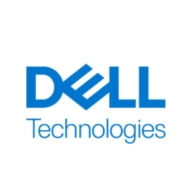

ExtremeSwitching and Dell PowerEdge R-Series compete in the networking and server infrastructure market. Dell PowerEdge holds an advantage in reliability and server management tools, while ExtremeSwitching is noted for its aggressive pricing and unique protocol features.
Features: ExtremeSwitching provides deep packet inspection, scalable solutions, and cost-effectiveness. Dell PowerEdge R-Series excels in reliability, remote management with iDRAC, and flexible configuration and scalability options.
Room for Improvement: ExtremeSwitching needs better training resources and more competitive international pricing, as well as interface and wireless technology support enhancements. Dell PowerEdge could improve pricing, support services, and address challenges in parts availability and hardware compatibility.
Ease of Deployment and Customer Service: ExtremeSwitching is praised for customer service and after-sales support, but could improve training resources for smoother deployments. Dell PowerEdge offers flexibility in deployment with strong customer service, though price sensitivity is a concern.
Pricing and ROI: ExtremeSwitching offers competitive pricing, often seen as more affordable than Cisco and HP, providing satisfactory ROI with reduced maintenance costs. Dell PowerEdge is noted for fair pricing and competitive negotiation terms, though its pricing can be higher than some competitors.
By not having to worry about it, I would estimate we save two to four hours a week, depending on what's happening, such as if we need to spin up a new server, which would contribute to more time if done the old way.
In my immediate case for antenna analysis, Dell PowerEdge Rack Servers offer a reduction from days of computing to half a day or hours.
The value of uptime to us is critical.
The return on investment is high.
In the future, we can convince the customer to make use of 100G capability to suffice their requirement, but at the moment we are using 40G only.
I would give Dell PowerEdge Rack Servers a ten because they're always able to answer all the questions we have; they reach a solution no matter how long it takes, and they don't give up.
It has always been scheduled maintenance, which says a lot for a production environment, as we haven't had to call in a trouble ticket for the actual hardware during its entire run.
Typically, the contacts we have on-site are very knowledgeable, they come in within a day and usually have it fixed and taken care of if there are issues.
Requiring improvement in the technical support provided to customers.
The scalability of Dell PowerEdge Rack Servers is excellent.
Any outages or blackouts are limited to particular servers, not affecting the whole chassis or enclosures.
We bought our product with scaling involved, and we've been scaling it up anytime we've needed more storage.
ExtremeSwitching is highly scalable, and I would rate it as nine out of ten.
Over four years, we've had less than 1 percent downtime.
There is a feature to update the server while it is running, so there is no need to restart.
We have truly not had any downtime on the infrastructure at all.
The stability for ExtremeSwitching is excellent.
We need to know about any upcoming updates so that we can plan accordingly.
The beneficial aspect of that feature was that we could skip the PowerStore and just have the Dell PowerEdge Rack Servers alone, as they also served as storage, which helped us save money.
This forces you to go up to a larger server to get the desired processor, which increases the cost.
ExtremeSwitching's software stability could be improved, as it sometimes crashes.
Because I am not a networking specialist, I do not know much about the things in detail.
They have been stable and running for years without performance downtime or significant disc failures.
Some customers find it cheaper due to contractual agreements, while others find it expensive, especially when scaling up.
The software associated with servers, like VMware subscription licenses, drives costs.
ExtremeSwitching is priced in the mid-range, not too expensive nor too cheap.
They keep running for at least five to seven years without any issues.
With PowerEdge Servers, I don't need a one-to-one ratio redundancy, which leads to about eighty percent downtime reduction.
One of the valuable features is Active Directory, which helps in managing the network.
The most valuable feature of ExtremeSwitching is the Extreme Fabric, specifically the switching fabric.
| Product | Market Share (%) |
|---|---|
| Dell PowerEdge R-Series | 3.1% |
| ExtremeSwitching | 7.3% |
| Other | 89.6% |


| Company Size | Count |
|---|---|
| Small Business | 94 |
| Midsize Enterprise | 58 |
| Large Enterprise | 111 |
| Company Size | Count |
|---|---|
| Small Business | 11 |
| Midsize Enterprise | 8 |
| Large Enterprise | 7 |
PowerEdge R-Series delivers high performance, flexibility, and scalability for data centers. It supports demanding tasks with robust management tools and advanced cooling, providing reliability and efficiency across various workloads.
Engineered for large deployments, PowerEdge R-Series supports extensive configurations optimizing performance in data centers. With features like advanced cooling and energy-efficient architecture, it empowers organizations to manage heavy workloads while facilitating seamless scalability. It offers remote management, robust security, and integration with VMware ensuring operational excellence and high availability for business-critical applications.
What are the key features of Dell PowerEdge R-Series?PowerEdge R-Series is deployed across industries for virtualization, database hosting, and application servers. It supports environments like VMware and Hyper-V for AI, cloud infrastructure, and computing tasks. Widely used by finance, healthcare, and academia, it enhances reliability and efficiency of IT infrastructure.
We monitor all Data Center Networking reviews to prevent fraudulent reviews and keep review quality high. We do not post reviews by company employees or direct competitors. We validate each review for authenticity via cross-reference with LinkedIn, and personal follow-up with the reviewer when necessary.